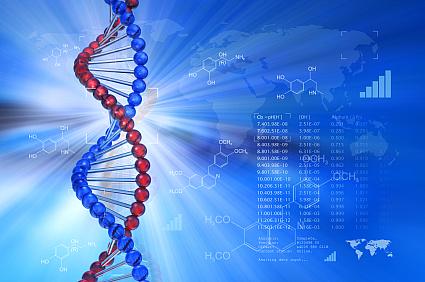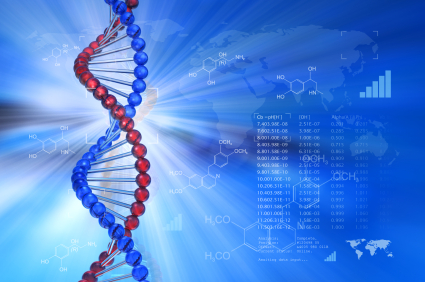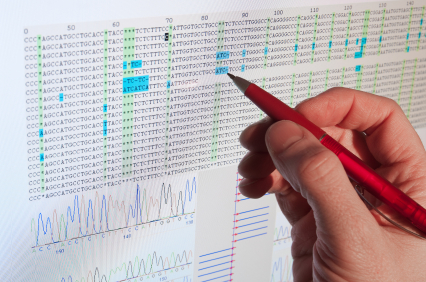Writing about Personal Genomics in the Postgenomic Era

 I'm not a trained journalist nor do I play one on television. But if I'm not a card-carrying journalist, then what am I?
I'm not a trained journalist nor do I play one on television. But if I'm not a card-carrying journalist, then what am I?
Depending on who's doing the asking, I will say "an academic," "a policy researcher," "a recovering geneticist," and/or "a writer."
My ideas on personal genomics and writing about it should be looked at not as a large case-controlled double-blind clinical trial, but as a peculiar case study: an outlier. I write about DNA neither as a dispassionate observer nor as an unquestioning believer, but as someone who has long since been emotionally and intellectually invested in its power and limitations as science, medicine, culture and epistemology and more recently as a participatory exercise. I want to try to understand all of it.
I am, as they say, "all in."
Convergent Evolution
Here is how I came to write my book, Here Is a Human Being: At the Dawn of Personal Genomics.
In early 2006, I picked up the current issue of Scientific American and saw that the cover story was entitled "Genomes for All," written by a guy named George Church, a prominent geneticist at Harvard. For me it was an epiphany. Church was articulating things that I had felt for a long time, e.g., that it was time to include the masses in the act of genome sequencing. George would be the anchor of the book I would spend the next three and a half years writing. With his help (and that of my colleague David Goldstein) I had my own genome sequenced.
George was not only at the epicenter of the technology behind cheap DNA analysis, he advised startup companies whose aim was to deliver genomic data from such analyses to the public. He was also ready to challenge the prevailing attitudes (fear, determinism) that had long since governed society's view of genetics. By observing the field through his eyes and the eyes of many other participants, I was afforded a terrific view of personal genomics in its nascent manifestations.
Here's a tiny bit of what I learned:
1. The technology to decode human genomes continues to decline in price such that in the next couple of years (or maybe sooner) it will be possible to sequence an entire human genome-a task that took the public Human Genome Project 13 years and $3 billion-in a matter of hours for $1,000.
2. No matter how economically feasible DNA sequencing becomes, the powers that be are for the most part not ready for the genomes-for-all ethos and sharing of fully identifiable biological and health data.
3. That said, there are grassroots movements, startup companies and even folks in the Department of Health and Human Services who are deeply dissatisfied with the status quo and are pushing for change. Their numbers are growing and their voices are getting louder.
4. The emergence of consumer genomics companies such as 23andMe that, for a few hundred dollars, allow people to spit in a tube and learn something about a small fraction of their genetic makeup, has received a great deal of publicity, but it remains to be seen how much beef consumer genomics has to offer over the long haul.
5. These companies' legacy is mixed. They have failed to develop industry standards and have been rightly criticized for overselling their services as extraordinarily powerful tools for health improvement. They have appealed almost exclusively to a well-heeled customer base that is mostly of European descent, which at least partially belies their claim to be "democratizing genetics." My hope is that this trend is starting to change.
6. But even if these companies have not quite democratized genetics, they have had some success in prying it away from its white-coated gatekeepers. They have developed educational tools and novel ways of presenting genetic information to lay people that are easier to understand and much more compelling than most high school genetics curricula. They have been important catalysts for and participants in the conversation about what genomic data mean, to whom, and in what context.
7. Consumer genomics companies remain in the crosshairs of regulators and have attracted negative attention from Congress and the Food and Drug Administration, among others, that seems to me to be in great disproportion to their rather small (so far) market.
8. To a large extent, personal genomics' limited utility to the person on the street is a function of the broader disappointments seen in human genetics and genomics laboratories over the last few years. We now know that most common diseases and human traits of interest, while harboring significant genetic components, are governed by many genes interacting with the environment in ways we do not understand. Height, for example, has a lot to do with heredity, but it is now strikingly clear that it involves thousands of genes.
9. This is not to say that personal genomics is useless. On the contrary, it can be powerful indeed when applied to certain heritable traits: response to certain pharmaceuticals, for example, and carrier status for single-gene disorders such as cystic fibrosis and sickle-cell disease. These are the low-hanging fruit; such information increasingly will not be limited to doctors' offices but rather will be made widely available to those who want it. Meanwhile, genetic ancestry testing-using DNA to make sense of our genealogies and pinpoint our ancestral origins-continues to capture the attention of the public, as evidenced by the success of research initiatives such as the Genographic Project and television programs such Henry Louis Gates' Faces of America.
 Caveat Scriptor
Caveat Scriptor
What is required to write about personal genomics and personalized medicine in a robust and compelling way?
For starters, it requires the same banal but crucial elements that any sort of good journalism does: tenacity, skepticism, and storytelling, along with the immortal William Zinsser's four essentials of good writing-simplicity, clarity, brevity and humanity. (If you haven't looked at your dog-eared copy of On Writing Well in a while, you should-it seems to get better with age.)
Beyond those attributes, I would circle two more:
1. The ability to talk the talk. Pulitzer-Prize winning nature and narrative nonfiction writer John McPhee likes to ask his subjects stupefyingly basic, elemental questions about what they do, so much so that if they are not familiar with his work they often come away thinking that he's as dumb as a post. It's hard to argue with McPhee's results-he is one of the giants in the field and has been for four decades. But most of us mortals are not in a position to call up a Nobel Prize winner and ask, "What is this DNA thing anyway?" Which is not to say that one needs a PhD-indeed, I would even entertain the argument that it can get in the way. But one still needs to do one's homework. Understanding the science has left me better equipped to ask follow-up questions and discern what is true and what is most important for a story. This also has a bearing on the next crucial trait
2. Universal suspicion. Think of this as skepticism blended with paranoia. When a company executive tells you that his new sequencing machine will read a human genome in 15 minutes for $30, that's pretty transparent hype and fairly easy to prove or disprove. But one needn't be in private industry in order to foment sensationalism. A recent example: a Boston University team published a paper in 2010 claiming that it had discovered a genetic signature associated with longevity-people with a collection of certain genetic variants would presumably be much more likely to live to 100. After some breathless press coverage about "Methuselah genes" and the like (much of it based on the university's pre-embargo press release), other scientists and the science blogosphere began scrutinizing the BU team's Science paper and realized that something didn't smell right: the control and experimental samples were analyzed differently. In July 2011, the paper was retracted.
This case was memorable for me because I was on the other end of the microphone and I failed to follow my own advice. A reporter called and asked me to speculate about the implications of the longevity paper, which I did, all the while protesting that I hadn't read it. Shame on me. But whether one is a journalist or a scientist, healthy skepticism should be the default mode. The question we could all stand to ask more frequently, of scientists and indeed, of ourselves, is this: What if you're wrong?
In writing my book, I talked with a number of academic and government scientists and physicians inclined to criticize personal genomics companies. But few of these individuals were willing to acknowledge that the emergence of such companies was partly a reaction against the longstanding frustrations and paternalism of academic genetic medicine or that it threatened their own professional standing. The obvious take-home: true objectivity is a difficult thing to find and the realm of personal genomics is no exception. Most of us act in accord with our own self-interests. It is the writer's job to know what those interests are in every case, not just when talking to venture capitalists or titans of industry.
The Next Big Things?
I would argue that, most of the time, setting out to write an in-depth story about "what's hot" in personal genomics is going to be a mistake. As I said, the field is changing so fast that what seems au courant today might very well not be by the time a piece reaches the dead-tree copyediting stage. This is partly why I tweet more than I blog and why I blog more than I write 8,000-word articles, be they popular or scholarly.
So what might justify dozens of hours of interviews and thousands of words committed to paper and pixels? I try to write about people who are involved in activities on the fringe, who are doing strange, novel and edgy things, and whose evolution I can follow over time.
If I were given the personal genomics beat, here are some story ideas I would seriously consider pursuing:
1. Yes, But What Does It Mean? The new meme is that we will have "a $1,000 genome and a million-dollar interpretation." But how? Beyond $1 million, what will it take before we can interpret human genomes in useful ways that will have meaning for scientists and physicians, let alone the average person?
2. Clouds Full of Genomes. At one time Google was poised to sink serious money into personal genomics; thus far, however, its investments have been fairly modest. In the wake of the company's announcement that it will shutter Google Health, where does this leave the exponentially growing reams of personal genome data? What will become of every person's billions of bases?
3. The business of do-it-yourself biology. "DIY" and "business" might seem like an oxymoron, but is it? In my book I write about the growing subculture of people doing genetic experiments at home and in community laboratories. Marcus Wohlsen covers this space even more thoroughly in his excellent book Biopunk. But what is the economic engine driving this movement? Who and what are behind the peculiar potion of dumpster-diving, Kickstarter campaigns, foundation money and personal investment that allows DIYers to do what they do? How does the biotech hobbyist coexist with the ambitious entrepreneur?
4. Gamete donors and the search for "a clean genome." A woman wanting to conceive with donor sperm can choose what traits (tall, blond, thin, well-educated) she wants in her child's biological father. It seems inevitable that she will want the same control over her donor's genome. Will the largely unregulated sperm banking industry embrace whole-genome sequencing of donors? What genomic criteria, if any, should it use to include or exclude a potential donor? What about egg donors? And should such practices be thought of as eugenics?
5. Pay It Backward. For decades the default stance of biomedical researchers has been not to return data about the people they study to the people they study. The onslaught of social media, disappointment in the pace of clinical research, patient activism, and the arrival of potentially useful information contained in increasingly dirt-cheap DNA sequencing data have converged to make the status quo untenable. Sick babies for whom doctors can't provide a diagnosis are, in some cases, now having their entire genomes sequenced. What will the future look like? What should it look like?
Turn and Face the Strange
I am blessed beyond measure to have a day job in academia. Anyone who has tried to make a living as a writer in the last few years is painfully aware of the seismic changes that have gripped the print publication world. Science writing has been hit particularly hard as newspapers retrench and, in many cases, go under. I wish I could say "it's all going to be all right" with a straight face, but as far as what the future holds, I have no idea.
What I do know is that we are living in a Golden Age of science writing. The blossoming of science blogging networks and their constituent blogs, a number of which cover personal genomics, has been a glorious thing to behold. Print magazines have cultivated an online presence, and even if some content remains sequestered behind pay walls, anyone with WiFi has access to an extraordinary sea of information.
Nor is long-form writing about human biology going away anytime soon. My older brother, an economist, once said to me in jest (I think), "The problem with you writers is that you think you can learn things just by talking to people." Touché, bro. We do think that and, if it's done right, we think it for good reason. Read Jonathan Weiner's Long for this World, Rebecca Skloot's The Immortal Life of Henrietta Lacks, Richard Preston's The Hot Zone, or anything by Mary Roach, and the value of "just talking to people" and writing about it becomes self-evident.
The formal end of the Human Genome Project in 2003 was hardly "The End." It might have been, to paraphrase Churchill, the end of the beginning. In the meantime, if we have lowered our expectations of the human genome, maybe that's not such a bad thing. Future genomic discoveries are likely to come from unexpected places in unexpected ways...they usually do.
DNA is not destiny. It never was.
But it is still worthy of our attention.
 Misha Angrist is Assistant Professor at the Duke University Institute for Genome Sciences & Policy and writes the Genome Boy blog. His book, Here is a Human Being: At the Dawn of Personal Genomics, was published by HarperCollins in 2010.
Misha Angrist is Assistant Professor at the Duke University Institute for Genome Sciences & Policy and writes the Genome Boy blog. His book, Here is a Human Being: At the Dawn of Personal Genomics, was published by HarperCollins in 2010.

